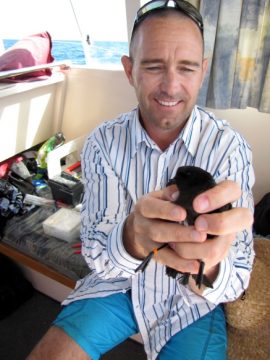Ornithologist Matt Rayner talks about the decline of seabirds in the Hauraki Gulf
Seabirds are a perfect indicator of marine health and studying them can reveal the major impacts humans are having. Matt Rayner is a professional ornithologist who does just that, and in his blog reveals some of the big changes he has seen in the Hauraki Gulf and why he volunteers for Forest & Bird’s campaign action group to save the Hauraki Gulf.
Why this career path?
I am curator of land vertebrates at Auckland Museum and a professional ornithologist who specialises in studying New Zealand’s seabirds. I completed my doctorate on the Hauraki Gulfs Cook’s petrel in 2008 and have since been working to understand the amazing biology of the gulfs 27 breeding seabird species and how these birds have been impacted by our changes to the marine environment.

New Zealand storm petrel captured at sea as part of our discovery of the birds breeding on Little Barrier Island.
The gulf was the inspiration for my career path. I love the ocean being a keen surfer, fisher and ocean swimmer. When my parents bought a yacht when I was 10 I spent every summer out on the water and was exposed to the excitement and beauty of oceanic birds; mixed flocks of shearwaters, gulls and terns feeding over kahawai and trevally schools, noise and white water, gannets diving on bait balls amidst pods of excited dolphins. I was hooked!
What changes have you seen in the Hauraki Gulf?
Unfortunately I have seen big and bad changes in the gulf in my 44 years. The big huge schools of bait fish, and predators like kahawai, that were always out the back of Waiheke in my childhood, are pretty much gone and the numbers of boats out there hammering fish stocks are mind boggling. The seabirds are really suffering too. The big colonies of red-billed gulls, which used to feed on zooplankton chased to the surface by predatory fish, are all but gone. On the Mokohinau Islands there were 13 000 red-billed gulls breeding in the 1940s and 50s, today a couple of hundred pairs make a home there. Likewise the large colonies of white fronted terns that feed on small fish are no more. Spotted shags, that are endemic to the gulf and distinct from bird’s elsewhere in New Zealand, have declined from around ten colonies in the 1980s to one major colony in the Firth of Thames. My research, using molecular markers in museum specimens, has traced the diet and habitat use of these seabirds over the past 130 years and revealed big problems. Fish specialist birds, such as shags, have literally had to change their diet by feeding down the food chain on smaller prey like zooplankton to survive. They also have to travel further from home, offshore, to find their food as do our friends the little blue penguins that have also declined in number in the gulf.
Why did you join the campaign?
I joined the campaign because I am deeply concerned about the future of our beautiful gulf and I am frustrated by the lack of action by regional and national governments meaning it’s time for some grass roots action. So many of us love and use the gulf but we have fallen into an intergenerational habit of take, take, take without ever considering that we might need to give something back by reducing our impact on the marine environment. We need to act now before it is to late.
*****
Add your voice to the campaign. Tell the NZ Government to put the Sea Change plan into action as a package and without delay at www.forestandbird.org.nz/seachange. The health of the Hauraki Gulf depends not just on what goes on under the water but on the land and in the air around it. Seabirds are a crucial component of the marine ecosystem and this plan tackles many of the threats facing them.
